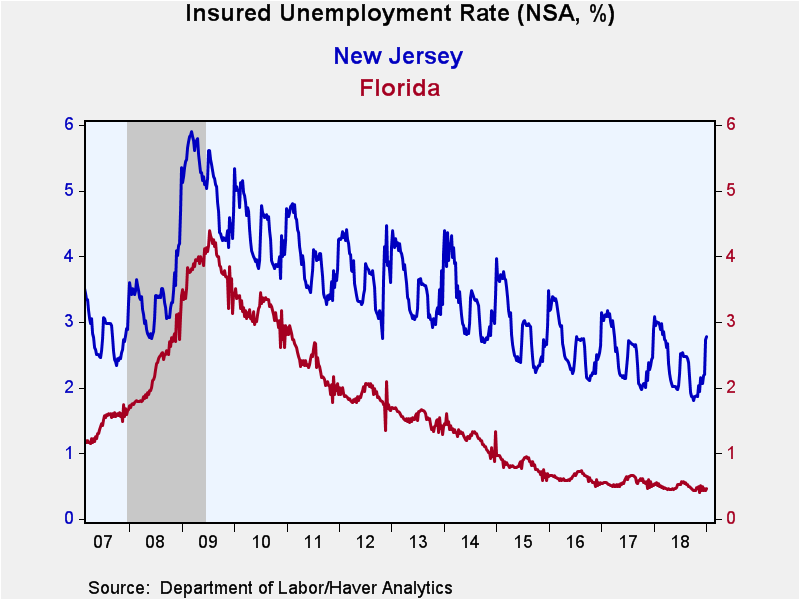 Global| Jan 24 2019
Global| Jan 24 2019U.S. Initial Unemployment Insurance Claims Fell to 50-Year Low
by:Sandy Batten
|in:Economy in Brief
Summary
Initial claims for jobless insurance unexpectedly fell to 199,000 in week ended January 19 from a downwardly revised 212,000 in the previous week. The Action Economics Forecast Survey expected 216,000 claims. This is the lowest [...]
Initial claims for jobless insurance unexpectedly fell to 199,000 in week ended January 19 from a downwardly revised 212,000 in the previous week. The Action Economics Forecast Survey expected 216,000 claims. This is the lowest reading on claims since November 1969 when the labor force was half its current size. The four-week moving average slipped to 215,000 from 220,500. During the last ten years, there has been a -73% correlation between the level of initial claims and the m/m change in nonfarm payrolls.
Continuing claims for unemployment insurance fell to 1.713 million in the week ended January 12 from 1.737 million the previous week. The four-week moving average of continuing claims edged up to 1.730 million from 1.729 million. This is the highest reading since mid-August of last year.
How has the federal government shutdown impacted these figures? Not likely very much directly. There could be some indirect effect as employees of government contractors that have been furloughed by the shutdown apply for benefits. The initial claims figures are reports from state-run programs. Unemployed federal government employees would apply for benefits from federal programs, not the programs included in these headline figures. However, the initial claims report contains not seasonally adjusted information on these federal unemployment insurance programs with a one week lag. In the week ended January 12, 25, 419 federal employees filed for unemployment benefits, up from 1,658 in the same week a year ago. On average, around 800-1000 federal employees apply for unemployment benefits each week. The current shutdown is partial. So, not all federal employees are eligible to apply for benefits.
The insured unemployment rate held steady at 1.2% in the week ended January 12, after hitting a record low of 1.1% last November. The figure compares the number of people receiving benefits to the number covered by unemployment insurance.
Insured unemployment rates vary widely by state. During the week ending January 5, the lowest rates were in Florida (0.47%), North Carolina (0.49%), Tennessee (0.65%) and Virginia (0.66%). The highest rates were in Higher rates were in Alaska (3.46%), New Jersey (2.78%), Connecticut (2.66%) and Pennsylvania (2.60%). The state data are not seasonally adjusted.
Data on weekly unemployment claims going back to 1967 are contained in Haver’s WEEKLY database and are summarized monthly in USECON. Data for individual states are in REGIONW. The expectations figure is from the Action Economics Forecast Survey, carried in the AS1REPNA database.
| Unemployment Insurance (SA, 000s) | 01/19/19 | 01/12/19 | 01/05/19 | Y/Y % | 2018 | 2017 | 2016 |
|---|---|---|---|---|---|---|---|
| Initial Claims | 199 | 212 | 216 | -13.1 | 221 | 243 | 264 |
| Continuing Claims | -- | 1,713 | 1,737 | -10.9 | 1,763 | 1,964 | 2,143 |
| Insured Unemployment Rate (%) | -- | 1.2 | 1.2 |
1.4 |
1.2 | 1.4 | 1.6 |
Sandy Batten
AuthorMore in Author Profile »Sandy Batten has more than 30 years of experience analyzing industrial economies and financial markets and a wide range of experience across the financial services sector, government, and academia. Before joining Haver Analytics, Sandy was a Vice President and Senior Economist at Citibank; Senior Credit Market Analyst at CDC Investment Management, Managing Director at Bear Stearns, and Executive Director at JPMorgan. In 2008, Sandy was named the most accurate US forecaster by the National Association for Business Economics. He is a member of the New York Forecasters Club, NABE, and the American Economic Association. Prior to his time in the financial services sector, Sandy was a Research Officer at the Federal Reserve Bank of St. Louis, Senior Staff Economist on the President’s Council of Economic Advisors, Deputy Assistant Secretary for Economic Policy at the US Treasury, and Economist at the International Monetary Fund. Sandy has taught economics at St. Louis University, Denison University, and Muskingun College. He has published numerous peer-reviewed articles in a wide range of academic publications. He has a B.A. in economics from the University of Richmond and a M.A. and Ph.D. in economics from The Ohio State University.










